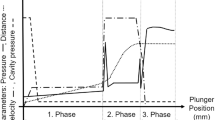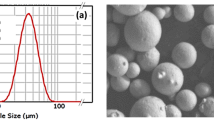Abstract
Porosity is one of the challenges in high-pressure die casting (HPDC) of aluminum alloys. A typical control of porosity involved controlled solidification which is attained by the cooling of the die. In traditional cooling, this is done by straight cooling channels. However, they can be ineffective due to the limited geometry of these channels. Alternatively, conformal cooling channels can be produced in any geometry by additive manufacturing. In this study, the thermal analysis of the mass production engine crankcase die was performed and the regions where the metal-die heat transfer load is high and limiting the production rate were examined. In order to increase the heat transfer and maximize the cooling rate in the different locations of the mold, conformal cooling inserts were designed and produced in a direct metal laser sintering 3D print machine by additive manufacturing technology. AlSi9Cu3 alloy was used to produce the cast part by HPDC. It was observed that porosity was decreased by 43% (from 251 to 156 mm3) and the cycle duration was decreased by 4 s when conformal cooling was used. Secondary dendrite arm spacing (SDAS) was decreased by 39% to 8.27 mm while eutectic silicon modification was enhanced.
















Similar content being viewed by others
References
Vinarcik EJ (2002) High integrity die casting processes. John Wiley & Sons
Shankar S, Apelian D (2002) Die soldering: mechanism of the interface reaction between molten aluminum alloy and tool steel. Metall Mater Trans B 33:465–476. https://doi.org/10.1007/s11663-002-0057-7
Han Q, Viswanathan S (2003) Analysis of the mechanism of die soldering in aluminum die casting: physical metallurgical and materials science. Metall Mater Trans 34A:139–146
Dutta B, Rettenmayr M (2000) Effect of cooling rate on the solidification behaviour of Al–Fe–Si alloys. Mater Sci Eng A 283:218–224. https://doi.org/10.1016/S0921-5093(00)00742-5
Sadeghi M, Mahmoudi J (2012) Experimental and theoretical studies on the effect of die temperature on the quality of the products in high-pressure die-casting process Adv. Mater Sci Eng 2012:434605. https://doi.org/10.1155/2012/434605
Podprocká R, Malik J, Bolibruchová D (2015) Defects in high pressure die casting process. Manuf Technol 15:674–678
Kaye A, Street A (2016) Die casting metallurgy: Butterworths monographs in materials. Elsevier
Campbell J (2015) Complete casting handbook: metal casting processes, metallurgy, techniques and design. Butterworth-Heinemann
Fiorentini F, Curcio P, Armentani E et al (2019) Study of two alternative cooling systems of a mold insert used in die casting process of light alloy components. Procedia Struct Integr 24:569–582
Norwood A, Dickens P, Soar R et al (2004) Analysis of cooling channels performance. Int J Comput Integr Manuf 17:669–678
Hu H, Chen F, Chen X et al (2004) Effect of cooling water flow rates on local temperatures and heat transfer of casting dies. J Mater Process Technol 148:57–67
Armillotta A, Baraggi R, Fasoli S (2014) SLM tooling for die casting with conformal cooling channels. Int J Adv Manuf Technol 71:573–583
Feng S, Kamat AM, Pei Y (2021) Design and fabrication of conformal cooling channels in molds: review and progress updates. Int J Heat Mass Transf 171:121082
Goulart PR, Spinelli JE, Osório WR, Garcia A (2006) Mechanical properties as a function of microstructure and solidification thermal variables of Al–Si castings. Mater Sci Eng A 421:245–253
Zhang L, Jiang Y, Ma Z et al (2008) Effect of cooling rate on solidified microstructure and mechanical properties of aluminium-A356 alloy. J Mater Process Technol 207:107–111
Mohandass M, Venkatesan A, Karthikeyan S et al (2014) Effect of cooling rate on mechanical behaviour of bulk cast of A380 aluminium alloy. Int J Eng Technol 6:374–380
Irfan M, Schwam D, Karve A, Ryder R (2012) Porosity reduction and mechanical properties improvement in die cast engine blocks. Mater Sci Eng A 535:108–114
Zamani M, Seifeddine S, Ghassemali E (2016) Effect of cooling rate and eutectic modification on texture and grain structure of Al-Si-Cu-Mg die cast alloy. Metall Ital 108:5–8
Kasprzak W, Sahoo M, Sokolowski J et al (2009) The effect of the melt temperature and the cooling rate on the microstructure of the Al-20% Si alloy used for monolithic engine blocks. Int J Met 3:55–71
Yamagata H, Kasprzak W, Aniolek M et al (2008) The effect of average cooling rates on the microstructure of the Al–20% Si high pressure die casting alloy used for monolithic cylinder blocks. J Mater Process Technol 203:333–341
Žbontar M, Petrič M, Mrvar P (2021) The influence of cooling rate on microstructure and mechanical properties of AlSi9Cu3. Metals 11:186
Lei T, Alexandersen J, Lazarov BS et al (2018) Investment casting and experimental testing of heat sinks designed by topology optimization. Int J Heat Mass Transf 127:396–412. https://doi.org/10.1016/j.ijheatmasstransfer.2018.07.060
Cho J-I, Kim C-W (2014) The relationship between dendrite arm spacing and cooling rate of Al-Si casting alloys in high pressure die casting. Int J Met 8:49–55. https://doi.org/10.1007/BF03355571
Władysiak R, Kozuń A, Pacyniak T (2017) The effect of water mist cooling of casting die on the solidification, microstructure and properties of AlSi20 alloy. Arch Metall Mater 62:187–194
Jahan SA, Wu T, Zhang Y et al (2017) Thermo-mechanical design optimization of conformal cooling channels using design of experiments approach. 45th SME North Am Manuf Res Conf NAMRC 45 USA 10:898–911. https://doi.org/10.1016/j.promfg.2017.07.078
Meckley J, Edwards R (2009) A study on the design and effectiveness of conformal cooling channels in rapid tooling inserts. Technol Interface J 10
Xu J, Li Y, Hu B et al (2019) Development of Al–Nb–B master alloy with high Nb/B ratio for grain refinement of hypoeutectic Al–Si cast alloys. J Mater Sci 54:14561–14576
Stolt R, Pour MA, Siafakas D (2021) Making additively manufactured cores with conformal tooling directly on a die-base. Procedia Manuf 55:200–204
Mercado-Colmenero JM, Martin-Doñate C, Rodriguez-Santiago M et al (2019) A new conformal cooling lattice design procedure for injection molding applications based on expert algorithms. Int J Adv Manuf Technol 102:1719–1746
Muvunzi R, Dimitrov DM, Matope S, Harms T (2021) A case study on the design of a hot stamping tool with conformal cooling channels. Int J Adv Manuf Technol 114:1833–1846
Kuo C-C, Chen W-H (2021) Improving cooling performance of injection molding tool with conformal cooling channel by adding hybrid fillers. Polymers 13:1224
Mercado-Colmenero JM, Torres-Alba A, Catalan-Requena J, Martin-Doñate C (2021) A new conformal cooling system for plastic collimators based on the use of complex geometries and optimization of temperature profiles. Polymers 13:2744
Torres-Alba A, Mercado-Colmenero JM, Caballero-GarciaMartin-Doñate JDDC (2021) Application of new triple hook-shaped conformal cooling channels for cores and sliders in injection molding to reduce residual stress and warping in complex plastic optical parts. Polymers 13:2944
Torres-Alba A, Mercado-Colmenero JM, Caballero-Garcia JDD, Martin-Doñate C (2021) A hybrid cooling model based on the use of newly designed fluted conformal cooling channels and fastcool inserts for green molds. Polymers 13:3115
Oh S-H, Ha J-W, Park K (2022) Adaptive conformal cooling of injection molds using additively manufactured TPMS structures. Polymers 14:181
Kuo C-C, Xu J-Y, Zhu Y-J, Lee C-H (2022) Effects of different mold materials and coolant media on the cooling performance of epoxy-based injection Molds. Polymers 14:280
Kanbur BB, Zhou Y, Shen S et al (2022) Metal additive manufacturing of plastic injection molds with conformal cooling channels. Polymers 14:424
Kuo C-C, Qiu S-X, Yang X-Y (2021) A low-cost and highly efficient method of reducing coolant leakage for direct metal printed injection mold with cooling channels using optimum heat treatment process procedures. Int J Adv Manuf Technol 115:2553–2570
Jarfors AE, Sevastopol R, Seshendra K et al (2021) On the use of conformal cooling in high-pressure die-casting and semisolid casting. Technologies 9:39
Pujante J, González B, Garcia-Llamas E (2021) Pilot demonstration of hot sheet metal forming using 3D printed dies. Materials 14:5695
Abbès B, Abbès F, Abdessalam H, Upganlawar A (2019) Finite element cooling simulations of conformal cooling hybrid injection molding tools manufactured by selective laser melting. Int J Adv Manuf Technol 103:2515–2522
Kuo C-C, Zhu Y-J, Wu Y-Z, You Z-Y (2019) Development and application of a large injection mold with conformal cooling channels. Int J Adv Manuf Technol 103:689–701
Piekło J, Garbacz-Klempka A (2020) Use of maraging steel 1.2709 for implementing parts of pressure mold devices with conformal cooling system. Materials 13:5533
Kanbur BB, Suping S, Duan F (2020) Design and optimization of conformal cooling channels for injection molding: a review. Int J Adv Manuf Technol 106:3253–3271
Author information
Authors and Affiliations
Contributions
All authors contributed to the study conception and design. Material preparation, data collection, and analysis were performed by Can Karakoc and Kerem Can Dizdar. The first draft of the manuscript was written by Derya Dispinar, and all authors commented on all versions of the manuscript. All authors read and approved the final manuscript.
Corresponding author
Ethics declarations
Competing interests
The authors declare no competing interests.
Additional information
Publisher's Note
Springer Nature remains neutral with regard to jurisdictional claims in published maps and institutional affiliations.
Rights and permissions
About this article
Cite this article
Karakoc, C., Dizdar, K.C. & Dispinar, D. Investigation of effect of conformal cooling inserts in high-pressure die casting of AlSi9Cu3. Int J Adv Manuf Technol 121, 7311–7323 (2022). https://doi.org/10.1007/s00170-022-09808-7
Received:
Accepted:
Published:
Issue Date:
DOI: https://doi.org/10.1007/s00170-022-09808-7




